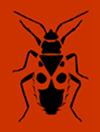生物入侵的遗传意义:科罗拉多马铃薯甲虫Leptinostarsa decemlineata(鞘翅目:金蜂科)旧大陆种群的染色体和DNA条形码单态性
IF 1.2
3区 农林科学
Q2 Agricultural and Biological Sciences
引用次数: 0
摘要
入侵物种一旦被引入到一个新的地区,由于奠基人效应,其遗传多样性很低。在这里,我们通过对亚美尼亚和白俄罗斯的科罗拉多马铃薯甲虫Leptinotarsa decemlineata种群(例如,1824年)的细胞遗传学和分子分析,并将结果与本地(北美)和引入欧洲的结果进行比较,验证了这一预测。结果表明,亚美尼亚和白俄罗斯雄性的核型明显保守,分别为2n = 35 (34 + X0)、n = 17AA + X0;包括一对大的顶心染色体。因此,这些种群属于所谓的科罗拉多马铃薯甲虫的顶心染色体种族。在初始阶段,有清晰可见的亲阿根廷信号,可能在某些常染色体二价体上存在NORs(核仁组织者区),而在减数分裂的不同阶段,X染色体均为亲阿根廷。c带显示少量的组成异染色质,在一些染色体的中心点周围区域微弱可见。对基因细胞色素c氧化酶亚基I (COI)的dna条形码片段分析显示,在亚美尼亚和白俄罗斯不同地点采集的所有样本中,都存在单一的单倍型(我们称之为“欧洲单倍型”),并且缺乏种群间变异。将我们的核学和分子数据与文献和GenBank中可用的数据进行比较表明,所有来自旧大陆的研究群体在核型和线粒体dna条形码方面都是单态的。我们假设(1)核型中存在的顶心染色体和(2)线粒体基因组的欧洲单倍型是旧大陆所有人群的祖先状态,并且继承自100年前殖民欧洲的新世界入侵者。新大陆种群在核型和线粒体基因方面具有多态性;然而,欧洲单倍型尚未在美洲发现。我们相信,未来它将在北美被发现,这将阐明这种危险害虫在欧亚大陆的种群起源。本文章由计算机程序翻译,如有差异,请以英文原文为准。
Genetic implications of a biological invasion: Chromosomal and DNA barcode monomorphism in Old World populations of Colorado potato beetle Leptinotarsa decemlineata (Coleoptera: Chrysomelidae)
Once introduced into new area, invasive species can be expected to have low genetic diversity due to the founder effect. Here we tested this prediction using cytogenetic and molecular analysis of Armenian and Belarusian populations of Colorado potato beetle Leptinotarsa decemlineata (Say, 1824) and by comparing the results with those of native (North America) and those introduced into Europe. This revealed that the karyotype of males from Armenia and Belarus is remarkably conserved with 2n = 35 (34 + X0), n = 17AA + X0; and includes a pair of large acrocentric chromosomes. Thus, these populations belong to the so-called acrocentric chromosome race of the Colorado potato beetle. At diakinesis there are clearly visible argentophilic signals, probably NORs (the nucleolus organizer regions) present on some autosomal bivalents, while the X chromosome was homogenously argentophilic during different stages of meiosis. C-banding revealed a small amount of constitutive heterochromatin weakly visible in the pericentromeric regions of some chromosomes. Analysis of the DNA-barcode fragment of the gene cytochrome c oxidase subunit I (COI) revealed a single haplotype (we call it “the European haplotype”) and lack of inter-population variability in all the samples collected from different locations in Armenia and Belarus. The comparison of our karyological and molecular data with that available in the literature and GenBank shows that all the populations studied from the Old World are monomorphic with respect to karyotype and the mitochondrial DNA-barcode. We assume that (1) the presence of acrocentric chromosomes in the karyotype and (2) the European haplotype of mitochondrial genome are the ancestral states for all populations in the Old World and inherited from the New World invaders who colonized Europe 100 years ago. New World populations are polymorphic with respect to karyotype and mitochondrial genes; however, the European haplotype has not yet been found in America. We believe that in the future it will be found in North America, which will shed light on the origin of populations of this dangerous pest in Eurasia.
求助全文
通过发布文献求助,成功后即可免费获取论文全文。
去求助
来源期刊
CiteScore
2.30
自引率
7.70%
发文量
43
审稿时长
6-12 weeks
期刊介绍:
EJE publishes original articles, reviews and points of view on all aspects of entomology. There are no restrictions on geographic region or taxon (Myriapoda, Chelicerata and terrestrial Crustacea included). Comprehensive studies and comparative/experimental approaches are preferred and the following types of manuscripts will usually be declined:
- Descriptive alpha-taxonomic studies unless the paper is markedly comprehensive/revisional taxonomically or regionally, and/or significantly improves our knowledge of comparative morphology, relationships or biogeography of the higher taxon concerned;
- Other purely or predominantly descriptive or enumerative papers [such as (ultra)structural and functional details, life tables, host records, distributional records and faunistic surveys, compiled checklists, etc.] unless they are exceptionally comprehensive or concern data or taxa of particular entomological (e.g., phylogenetic) interest;
- Papers evaluating the effect of chemicals (including pesticides, plant extracts, attractants or repellents, etc.), irradiation, pathogens, or dealing with other data of predominantly agro-economic impact without general entomological relevance.

 求助内容:
求助内容: 应助结果提醒方式:
应助结果提醒方式:


